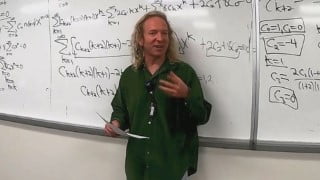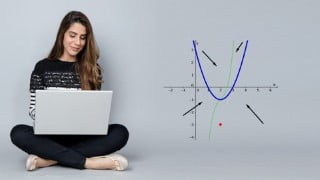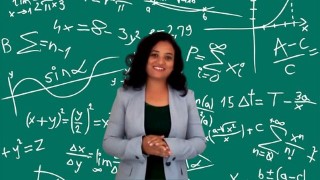Differential Equations Lectures with The Math Sorcerer
Learn differential equations with this comprehensive course. Suitable for self-study or college preparation, it covers all essential topics. Basic calculus skills are required, and assignments and a final exam are included. Perfect for anyone interested in mastering differential equations.
What you’ll learn
- What is a Differential Equation
- The Difference Between Ordinary and Partial Differential Equations
- How to Find the Order of a Differential Equation
- How to Determine if a Differential Equation is Linear or Nonlinear
- The Definition of a One Parameter and a Two Parameter Family of Solutions
- The Definition of the General Solution
- The Definition of a Singular Solution
- How to Find the Interval of Definition
- The Definition of a Particular Solution
- The Definition of an Initial Value Problem(I.V.P.) and What it Means Graphically
- How to Solve an Initial Value Problem
- How to Solve Separable Differential Equations
- How to Solve Linear Differential Equations by Finding using the Integrating Factor
- How to Determine if a Differential Equation is Exact
- How to Solve Exact Differential Equations
- The Definition of a Homogeneous Function
- How to Determine if a Differential Equation is Homogeneous
- How to Solve Homogeneous Differential Equations
- How to Solve Bernoulli Differential Equations
- How to Solve Differential Equations of the Form dy/dx = f(Ax + By + C)
- How to use Newton’s Law of Cooling to Solve a Word Problem
- The Definition of Linear Independence and Dependence Applied to Functions
- How to Prove a Set of Functions is Linearly Dependent or Indepenent
- How to Compute the Wronksian of a Set of Functions
- How to Use the Wronskian to Show Functions are Linearly Independent
- The Terminology and Theory Surrounding Solutions of Linear Homogeneous Differential Equations with Constant Coefficients
- What it Means Graphically for Two Functions to Be Independent or Dependent
- Motivation and Proof Sketch for the Method used to Solve Linear Differential Equations with Constant Coefficients
- How to Solve Linear Homogeneous Differential Equations with Constant Coefficients by Using the Auxiliary/Characteristic Equation
- How to Use the Rational Roots Theorem, Quadratic Equation, and Various Factoring Techniques to Solve Linear DE’s
- How to Solve Initial Value and Boundary Value Problems with Linear DE’s
- How to Use The Method of Undetermined Coefficients to Solve Linear Nonhomogeneous Differential Equations with Constant Coefficients
- How to Find the Complementary Function
- How to Find the Form of the Particular Solution y_p
- How to Use Variation of Parameters to Solve Linear Nonhomogeneous Differential Equations
- How to Solve Cauchy-Euler Differential Equations
- How to Find the Laplace Transform of a Function using the Definition
- How to Find the Laplace Transform of a Piecewise Function using the Definition
- How to Find the Laplace Transform from a Graph using the Definition
- How to Use Formulas to Find the Laplace Transform of a Function
- How to Find the Inverse Laplace Transform of a Function
- How to Use the First Translation Theorem for Laplace Transforms
- How to Solve Initial Value Problems using Laplace Transforms
- How to Use Partial Fractions to Solve Laplace Transform Problems
- How to Use the Heavyside Coverup Method in Laplace Transform Problems
- The Definition of Convergence of a Series
- How to Use The nth Term Test for Infinite Series
- How to Use the p-test for Infinite Series
- How to Use The Alternating Series Test for Infinite Series
- How to Use The Ratio Test for Infinite Series
- How to Use The Root Test for Infinite Series
- How to Use The Direct Comparison Test for Infinite Series
- How to Use The Limit Comparison Test for Infinite Series
- Understand The Convergence Theorem for Series – Both the Real and Complex Case
- How to Find the Interval and Radius of Convergence for an Infinite Series
- How to Find Two Linearly Independent Solutions to a Differential Equation
- How to Solve Differential Equations using Power Series
- How to Solve an Initial Value Problem using Power Series
Show moreShow less
This is a complete course on differential equations. The material covered in this course is equivalent to what is taught at most colleges. There might be some topics that you will see here that you don’t see in a college course, and there might be some that are missing from a regular college course. Overall though, this is a very complete course.
You should have basic differentiation and integration skills in order to understand this course. Normally the requirement for Differential Equations is Calculus 2, but I would say as long as you can differentiate and you know some basic integration techniques such as u-substitution you should be able to follow along. Integration by Parts and other techniques are used but they are carefully reviewed when they are introduced. The pace is good and you should be ok as long as you know some basic calculus. You will probably learn a great deal of calculus and other things as you go through this course.
Here are some of the highlights of this course.
29 Full Lectures. In some cases there is more than one version of a particular lecture.
16 Assignments with Solutions. There is an assignment for every single section in this course.
A Full Review for the Final Exam.
A Final Exam with Solutions.
This course is perfect for anyone who wants to learn differential equations on their own or wants to prepare for a course on differential equations at the college level. If you are currently taking differential equations, this course would of course be extremely helpful.
I sincerely hope that you enjoy this course as much as I have enjoyed creating it. The lectures, the assignments, and the final exam were very carefully created so that anyone with some basic calculus knowledge can learn the material.
Good luck and enjoy the course:)
Who this course is for:
- Anyone who wants to learn differential equations.
User Reviews
Be the first to review “Differential Equations Lectures with The Math Sorcerer”
You must be logged in to post a review.







There are no reviews yet.